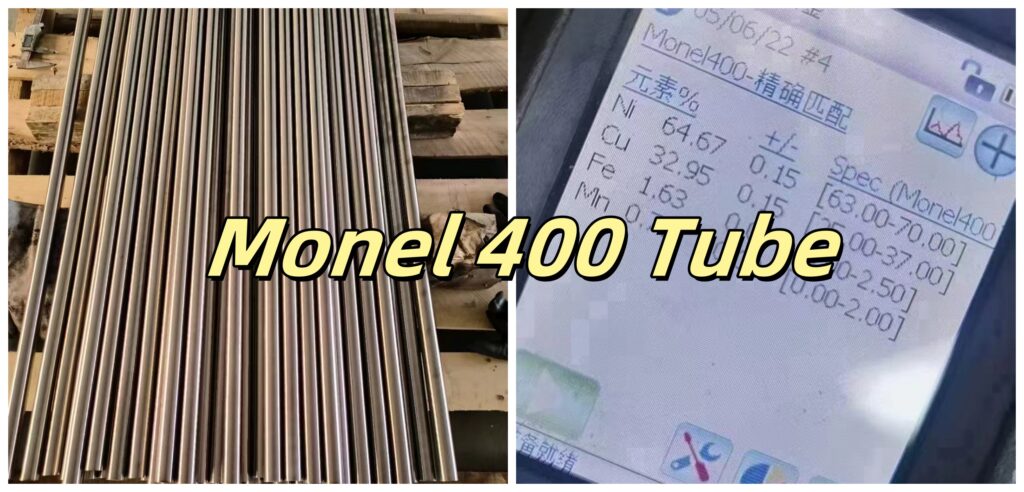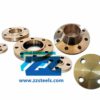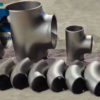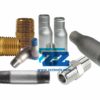
Monel 400 tube constructed in accordance with the specification covers not only the outside diameter but also its average wall. Moreover, the Monel 400 Seamless Tube also covers dimensions such as the outside diameter and minimum wall tube. Slightly magnetic at ambient temperature, the Monel Alloy 400 Tube is resistant to seawater and steam, as it is resistant to salt and caustic solutions at elevated temperature settings. Since we offer highly competitive prices, we are one of the most popular Monel 400 Tubing suppliers in China. To learn more about these prices, you can check Alloy 400 Tube price list.
ASME B163 UNS N04400 tubes are made of a nickel-copper alloy that is highly resistant to corrosion and has good mechanical properties,They are often used in high-performance applications.
What is a Monel tube?
A Monel tube is a pipe or tube made from a nickel-copper alloy called “Monel,” which is known for its excellent corrosion resistance, particularly to saltwater, making it ideal for marine applications like seawater handling systems, and is often used in chemical processing and other industries where high corrosion resistance is required; the most common type of Monel tube is “Monel 400” which is a ductile nickel-copper alloy with good weldability and high strength.
ASME B163 UNS N04400 Pipe Specification
Monel 400® tubing meets a number of industrial, international, MIL-SPEC, and other specifications, including:
| UNS: | N04400 |
| Specifications: | ASTM B165, ASTM B829, ASTM B775, ASTM B725, ASTM B163, ASTM B730, ASTM B751,AMS 4574 |
| International Specifications: | din 17752, VdTUV 2635 |
ASTM B163 Standard Scope
This specification covers seamless tubes of nickel and nickel alloys, as shown in Table 1, for use in condenser and heat-exchanger service.
This specification covers outside diameter and average wall, or outside diameter and minimum wall tube.
The sizes covered by this specification are 3 in. (76.2 mm) and under in outside diameter with minimum wall thicknesses of 0.148 in. (3.76 mm) and under, and with average wall thicknesses of 0.165 in. (4.19 mm) and under.
Tube shall be furnished in the alloys and conditions as shown in Table 2. For small diameter and light wall tube (converter sizes), see Appendix X2.
Terminology
Definitions:
average diameter, n—average of the maximum and minimum outside diameters, as determined at any one cross section of the tube.
tube, n—hollow product of round or any other cross section having a continuous periphery
Monel Alloy 400 Tubes Chemical Composition
The material shall conform to the composition limits specified in Table 1.
If a product (check) analysis is performed by the purchaser, the material shall conform to the product (check) analysis per Specification B880.
Table 1
| Element | Alloy 400 |
| C | 0.30 max |
| Mn | 2.00 max |
| Si | 0.50 max |
| S | 0.024 max |
| Cu | 28.00 – 34.00 |
| Fe | 2.50 max |
| Ni | 63.00 min |
ASME SB 163 UNS N04400 Monel Pipe Mechanical Properties
Mechanical Properties—The material shall conform to the mechanical properties specified in Table 2.
Hardness—When annealed ends are specified for tubing in the stress-relieved condition (see Table 2), the hardness of the ends after annealing shall not exceed the values specified in Table 2.
Table 2
| Condition | Tensile Strength, min. | Yield Strength, min. | Elongation, | Hardness, |
| ksi [MPa] | ksi [MPa] | min. % | HRB | |
| Annealed | 70 [483] | 28 [193] | 35 | – |
| Stress-Relieved | 85 [586] | 55 [379] | 15 | ≤75 |
Alloy 400 Tubes Equivalent Grades
| STANDARD | WERKSTOFF NR. | UNS | JIS | BS | GOST | AFNOR | EN |
| Monel 400 | 2.436 | N04400 | NW 4400 | NA 13 | МНЖМц 28-2,5-1,5 | NU-30M | NiCu30Fe |
What is the difference between Monel 400 and Monel 500?
Monel 400 is a standard nickel-copper alloy with good corrosion resistance, while Monel 500, also known as Monel K-500, is a precipitation-hardenable version of Monel 400, meaning it has significantly higher strength and hardness due to the addition of elements like aluminum and titanium, which allows for further strengthening through heat treatment; essentially, Monel 500 offers the same corrosion resistance as Monel 400 but with much greater mechanical strength.
Monel 400:
Corrosion Resistance: Excellent in both reducing and oxidizing environments, especially in seawater and acidic conditions.
Mechanical Properties: Good strength and toughness, suitable for a variety of industrial environments.
Processability: Easy to process and weld.
Monel 500:
Corrosion Resistance: Similar to Monel 400, but with the addition of aluminum and titanium to further improve corrosion resistance.
Mechanical Properties: Higher strength and hardness, suitable for high stress environments.
Processability: Good processing and welding performance, but slightly more difficult to process than Monel 400 due to the addition of aluminum and titanium.
Summary
Monel 400 is suitable for general corrosion-resistant environments and has good processability and mechanical properties.
Monel 500 is based on Monel 400, but by adding aluminum and titanium, it improves strength and corrosion resistance and is suitable for more demanding applications.
Is Monel 400 better than stainless steel?
Whether Monel 400 is better than stainless steel depends on the specific application and the properties required. Both materials have unique advantages and limitations.
Corrosion Resistance
Monel 400:
Excellent resistance to saltwater, acidic, and alkaline environments.
Performs exceptionally well in marine applications and hydrochloric or sulfuric acid environments.
Resistant to stress corrosion cracking in chloride environments.
Stainless Steel:
Good resistance to corrosion in oxidizing environments (e.g., nitric acid).
316 stainless steel has better resistance to chlorides and pitting due to molybdenum content.
Prone to stress corrosion cracking in chloride-rich environments (e.g., seawater).
Winner: Monel 400 is superior in marine and highly corrosive environments, especially where chlorides or reducing acids are present.
Cost
Monel 400:
More expensive due to its high nickel content (~63%).
Typically 3-5 times the cost of stainless steel.
Stainless Steel:
More cost-effective, especially for large-scale applications.
Widely available and easier to source.
Winner: Stainless steel is more cost-effective.
Machinability and Weldability
Monel 400:
More difficult to machine due to its toughness and work-hardening tendency.
Can be welded using similar techniques to nickel alloys.
Stainless Steel:
Easier to machine and weld compared to Monel 400.
Austenitic stainless steels (e.g., 304, 316) are particularly weldable.
Winner: Stainless steel is easier to machine and weld.
Temperature Resistance
Monel 400:
Retains strength and corrosion resistance at both cryogenic and high temperatures (up to ~1000°F / 538°C).
Stainless Steel:
Performs well at moderate temperatures but loses strength at high temperatures.
Prone to scaling and oxidation at temperatures above ~800°F (427°C).
Winner: Monel 400 is better for extreme temperature applications.
In conclusion, Monel 400 is not universally “better” than stainless steel, but it outperforms stainless steel in specific, demanding environments. The choice depends on the application requirements, environmental conditions, and budget.
| Property | Monel | Stainless Steel |
| Cost | More expensive (high nickel content). | More affordable and widely available. |
| Corrosion Resistance | Exceptional, especially in seawater. | Excellent, but varies by grade (316 is superior to 304). |
| Strength | High strength, even at elevated temperatures. | Moderate to high, depending on grade. |
| Hardness | Higher than most stainless steels. | Variable; 316 is softer compared to Monel. |
| Magnetism | Non-magnetic. | Can be magnetic (e.g., ferritic types). |
| Applications | Marine, chemical, and high-stress environments. | Construction, medical, food processing, and general-purpose. |
Alloy 400 pipe Dimensions and Permissible Variations
NOTE 1—The tolerances in the table apply to individual measurements of outside diameter and include out-of-roundness (ovality), and apply to all materials and all conditions, except that for thin wall tubes having a nominal wall of 3 % or less of the outside diameter, the mean outside diameter shall comply with the permissible variations of the above table and individual measurements (including ovality) shall conform to the plus and minus values of the table with the values increased by 1 ⁄2 % of the nominal outside diameter.
NOTE 2—Eccentricity—The variation in wall thickness in any one cross section of any one tube shall not exceed plus or minus 10 % of the actual (measured) average wall of that section. The actual average wall is defined as the average of the thickest and thinnest wall of that section.
NOTE 3—For tolerances of small diameter and light wall tube (converter sizes) see Appendix X2 (Table X2.2).
Permissible Variations in Outside Diameter and Wall Thickness of Condenser and Heat Exchanger Tubes
Table 3
| Material | Nominal Outside Diameter, in. (mm) | Permissible VariationsA | |||||
| Outside Diameter, in. (mm) | Wall Thickness,% | ||||||
| + | − | Average Wall | Minimum Wall | ||||
| + | − | + | − | ||||
| UNS N02200, UNS N02201, and UNS N04400 |
1⁄2 to 5⁄8 (12.7 to 15.9), excl | 0.005 (0.13) 0 | 12.5 | 12.5 | 25.0 | 0 | |
| 5⁄8 to 11⁄2 (15.9 to 38.1), incl | 0.005 (0.13) 0.005 (0.13) | 10.0 | 10.0 | 20.0 | 0 | ||
| over 11⁄2 to 3 (38.1 to 76.2), incl | 0.010 (0.25) 0.010 (0.25) | 10.0 | 10.0 | 22.0 | 0 | ||
| UNS N06600-UNS N08120 |
1⁄2 to 5⁄8 (12.7 to 15.9), excl | 0.005 (0.13) 0.005 (0.13) | 12.5 | 12.5 | 25.0 | 0 | |
| UNS N06686 | 5⁄8 to 11⁄2 (15.9 to 38.1), incl | 0.0075 (0.19) 0.0075 (0.19) | 10.0 | 10.0 | 20.0 | 0 | |
| over 11⁄2 to 3 (38.1 to 76.2), incl | 0.010 (0.25) 0.010 (0.25) | 10.0 | 10.0 | 22.0 | 0 | ||
Alloy,A Condition, Tube Size, and Bend Radii Limitations
| Table 4 | |||
| Tube OD, in. (mm) | Average Tube Wall, in. (mm)B | Minimum Bend Radius, in. (mm) |
|
| Annealed Condition |
Stress-Relieved Condition |
||
| Up to 1⁄2 (12.7), incl | 0.046 to 0.057 (1.17 to 1.45), incl | 13⁄16 (30.2) | 11⁄4 (31.8) |
| Up to 1⁄2 (12.7), incl | Over 0.057 to 0.120 (1.45 to 3.05), incl | 1 (25.4) | 11⁄8 (28.6) |
| Over 1⁄2 to 5⁄8 (12.7 to 15.9), incl | 0.037 to 0.057 (0.94 to 1.45), incl | 13⁄16 (30.2) | 11⁄4 (31.8) |
| Over 1⁄2 to 5⁄8 (12.7 to 15.9), incl | Over 0.057 to 0.120 (1.45 to 3.05), incl | 1 (25.4) | 13⁄16 (30.2) |
| Over 5⁄8 to 3⁄4 (15.9 to 19.0), incl | 0.049 to 0.057 (1.24 to 1.45), incl | 11⁄4 (31.8) | 11⁄2 (38.1) |
| Over 5⁄8 to 3⁄4 (15.9 to 19.0), incl | Over 0.057 to 0.109 (1.45 to 2.77), incl | 13⁄16 (30.2) | 11⁄4 (31.8) |
| Over 3⁄4 to 1 (19.0 to 25.4), incl | 0.049 to 0.058 (1.24 to 1.47), incl | 2 (50.8) | 4 (101.6) |
| Over 3⁄4 to 1 (19.0 to 25.4), incl | Over 0.058 to 0.109 (1.47 to 2.77), incl | 13⁄4 (44.5) | 21⁄4 (57.2) |
A Applies for all alloys except alloy UNS N08810, alloy UNS N08801, and UNS N08811.
B To determine the bend radius applicable to minimum wall tubing, compute the corresponding average wall from the wall tolerances in Table 3, then use Table 4.
Alloys, Size Ranges, and Yield Strength for Higher Yield Strength Tubes
| Table 5 | ||||
| Alloys | Size Range, in. (mm) | 0.2 % Yield Strength, ksi (MPa) | ||
| OD | Wall Thickness | Minimum | Maximum | |
| Nickel-chromium-iron Alloy UNS N06600 | 1⁄4 to 7⁄8 (6.35 to 22.23) | Up to 0.100 (2.54) | 40 (276) | 65 (448) |
| Nickel-chromium-iron Alloy UNS N06601 | 1⁄4 to 7⁄8 (6.35 to 22.23) | Up to 0.100 (2.54) | 40 (276) | 65 (449) |
| Nickel-iron-chromium Alloy UNS N08800 | 1⁄4 to 7⁄8 (6.35 to 22.23) | Up to 0.100 (2.54) | 40 (276) | 65 (448) |
| Nickel-chromium-iron Alloy UNS N06690 | 1⁄4 to 7⁄8 (6.35 to 22.23) | Up to 0.100 (2.54) | 40 (276) | 65 (448) |
What is Monel 400 used for?
● Marine engineering
● Chemical processing
● Oil and gas
● Heat exchangers
● Valves and pumps
● Nuclear power plants
● Mining
● Oil and refinery
● Pump shafts
● Oil well tools
● Propeller shafts
● Marine applications
● Pumping shafts
● Seawater valves
● Aerospace applications
● Frame structures
● Holding parts
● Exhaust assemblies
You can get an offer for products in below material forms:
-Pipe and Tube (EN 10216-5, ASTM A213, ASTM A249, A312, A790,)
-Forged Fitting and Flange (ASTM A182 , ASTM A105,ASTM B564 )
-Butt Weld Fittings (ASTM A234, ASTM A403,ASTM A815)
-Round bar , Billet (ASTM A276, ASTM A479)
– Plate, Sheet, Strip(ASTM A240, EN 10028-7, A480)
-Bolting, Nuts(ASTM A193, A194, A320)
Monel 400 Tube Exported Countries
We Export Monel 400 Tube to Saudi Arabia, United Arab Emirates, Qatar, Bahrain, Oman, Kuwait, Turkey, Egypt, Yemen , Syria, Jordan, Cyprus, Singapore, Malaysia, Indonesia, Thailand, Vietnam, South Korea, Japan, Sri Lanka, Maldives, Bangladesh, Cambodia, Argentina, Bolivia, Brazil, Venezuela, Colombia, Ecuador, Guyana, Paraguay, Uruguay, United States Of America, Canada, Mexico, Panama, Jamaica, Bahamas, Denmark, Norway, Germany, France,Italy, United Kingdom, Spain, Belgium, Greece, Czech Republic, Portugal, Hungary, Albania, Austria, Finland, Ireland, Croatia, Malta, Nigeria, Algeria, Angola, South Africa, Libya, Egypt, Sudan, Europe, Africa, Asia, North America, South America, Middle East.etc
Latest News
 02 8 月 2019Copper Nickel Flanges UNS C70600Zizi offers ISO certified copper nickel flanges, stores large quantity of Cu-Ni 90/10 weld neck flan...
02 8 月 2019Copper Nickel Flanges UNS C70600Zizi offers ISO certified copper nickel flanges, stores large quantity of Cu-Ni 90/10 weld neck flan...  29 7 月 2019Stainless Steel Buttweld Fittings ManufacturerZizi is stainless steel buttweld fittings manufacturer, we offer stainless steel pipe elbow, tee, ca...
29 7 月 2019Stainless Steel Buttweld Fittings ManufacturerZizi is stainless steel buttweld fittings manufacturer, we offer stainless steel pipe elbow, tee, ca...  19 7 月 2019Steel Pipe Nipple Types, Dimensions and MaterialsBasic pattern of steel pipe nipple is a short piece of pipe with threads at both end or at one end....
19 7 月 2019Steel Pipe Nipple Types, Dimensions and MaterialsBasic pattern of steel pipe nipple is a short piece of pipe with threads at both end or at one end....
